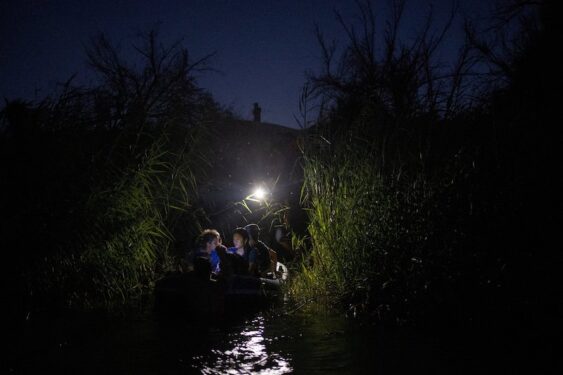
PROSPECT HEIGHTS — Father Pat Murphy remembers a family that for six months stayed and worked at La Casa Del Migrante in Tijuana, Mexico, and was on the verge of humanitarian parole before they fell susceptible to a smuggler and tried to enter the U.S. illegally.
They were promptly caught by border authorities and flown back to Honduras with dreams of a new life in the U.S. behind them, Father Murphy said. The family is just one of many that have risked their lives trusting smugglers to get them into the U.S., to no avail.
“Business is booming,” said Father Murphy, the executive director of La Casa Del Migrante. “There are coyotes who are becoming millionaires because there’s so much business.”
On June 27, the dangers of the “booming” business were realized after 53 migrants were found dead in an abandoned tractor-trailer on the outskirts of San Antonio. As it happened, something went wrong with the truck along Quintana Road and the driver fled, leaving the 67 migrants in the trailer to die in the triple-digit San Antonio heat.
It was the deadliest ever smuggling incident, however, it’s not the first time it’s happened. There have been a number of deadly smuggling-related incidents over the past two decades:
Last August, 10 people were killed when a van carrying more than two dozen migrants crashed in south Texas about 80 miles north of the U.S.-Mexico border.
In March 2021, 13 migrants were killed in Southern California when the SUV they were packed into drove into the path of a tractor-trailer.
In 2017, 10 men died in San Antonio due to a lack of water, fresh air, and food in the tractor-trailer they were packed into with about 200 other migrants. Nearly 30 more of the migrants in the truck were hospitalized.
In 2012, 15 migrants packed in a Ford pickup were killed when the vehicle struck two trees in south Texas.
In 2003, 17 migrants were found dead inside an overheated tractor-trailer in Victoria, a city in south Texas. Another migrant in the trailer later died at the hospital, bringing the death toll from the incident to 18.
In the aftermath of the tragedy, Catholic immigration leaders say a broken U.S. immigration system is to blame for the rise of smuggling, and the way to address it is by ending deterrent border policies like Title 42, reopening the asylum process, and creating new legal pathways for migrants with just cause to enter the U.S.
“Smuggling itself is a consequence of a broken system,” Bishop Mark Seitz of El Paso, the incoming U.S. Bishops Conference Migration Chair, said. “Smugglers aren’t out there in isolation from the rest of reality, and until we deal with the broader issues, smuggling will continue to be a question.”
There isn’t data on the exact number of migrants that turn to smugglers to try to enter the U.S. But it’s believed that the numbers continue to grow in the absence of an asylum process to enter the U.S. legally, and more volatile situations in many Central American countries that force people to flee out of desperation.
Marisa Limón Garza, senior director for advocacy and planning at the El Paso-based Hope Border Institute, highlighted this very reality, noting also the dangers that exist in Mexico that leave migrants with no other choice but to take their chances at entering the U.S.
“There are people on the move who have no other choice but to migrate … and so at some point when someone is so desperate and vulnerable, and someone — even if it’s a nefarious actor — gives you a lifeline, as risky as it may be, you take it.”
Joanna Williams, executive director of the Kino Border Initiative on the border in Arizona, put the onus on both the U.S. and Mexican governments. She said that both governments are “shirking in their responsibilities of protection and their responsibilities of having a functioning legal [immigration] system,” which is forcing migrants to turn to organized crime.
“It’s about the governments taking responsibility for the larger context,” Williams said.
“The U.S. government [should be] taking responsibility to give people another option of legal immigration, and … working with the government of Mexico and the governments in the region to make sure that people have the option to migrate as well,” she continued. “Then that disappears the demand, and as it were there will be no supply for smugglers.”
Outside of governmental action, Father Murphy suggested that the Catholic Church embark on a “massive” communications campaign to try and convince people that turning to smugglers isn’t the way to enter the U.S.
“The Church needs to be active in professing an anti-human trafficking message that convinces people that it’s not that easy,” Father Murphy said. “That’s a message we need to get out there and I’m not sure anybody’s doing that, including [in] the hotspots where people come from. Someone needs to tell people the truth.”
